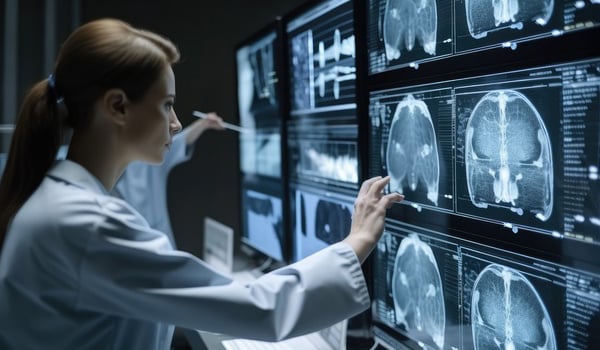Medical Image Analysis
This solution leverages the power of LLMs to enhance medical image analysis, assisting radiologists in interpreting images, identifying potential abnormalities, and providing insights for diagnosis and treatment planning. By training LLMs on vast datasets of medical images, clinical data, and research publications, this solution aims to improve diagnostic accuracy, efficiency, and patient care.

Common Challenges & Pain
Radiologists face an increasing workload and complexity in interpreting medical images, which can lead to variability in interpretation and potential delays in diagnosis. LLMs can assist in analyzing images, providing insights, and reducing the cognitive burden on radiologists.
- Image Interpretation Complexity
- High Workload & Time Constraints
- Variability in Interpretation
A PLATFORM STRATEGY
The Vertesia Approach
The platform integrates with existing Picture Archiving and Communication Systems (PACS) and Electronic Health Record (EHR) systems. LLMs analyze medical images, provide annotations, and generate reports that assist radiologists in interpreting findings and making informed decisions.
Image Ingestion & Preprocessing
The platform ingests medical images from various sources, such as CT scans, MRI scans, and X-rays. LLMs preprocess the images to enhance quality and prepare them for analysis.
Image Analysis & Feature Extraction
LLMs analyze the preprocessed images, identifying anatomical structures, potential abnormalities, and relevant features. The platform highlights areas of concern and provides annotations to assist radiologists in interpretation.
Report Generation & Insights
The platform generates reports that summarize image findings, provide potential diagnoses, and suggest relevant clinical information. LLMs assist in developing personalized treatment recommendations based on image analysis and patient data.
WHY VERTESIA
The Benefits of Medical Image Analysis with Vertesia
Enhanced Efficiency & Accuracy
LLMs can analyze vast datasets of medical images, patient records, and research publications, identifying patterns and anomalies with higher accuracy and speed than manual methods, assisting radiologists in diagnosis and treatment planning.
Improved Diagnostic Accuracy
LLMs can assist radiologists in interpreting medical images by highlighting potential areas of concern, comparing images with previous scans, and providing relevant clinical information, leading to more accurate diagnoses and better patient outcomes.
Personalized Treatment Recommendations
By analyzing patient data, medical history, and imaging findings, LLMs can assist in developing personalized treatment plans, predicting treatment responses, and recommending the most effective interventions for individual patients.

APPLICABLE INDUSTRIES
SOLUTION CATEGORY
DEPARTMENTS